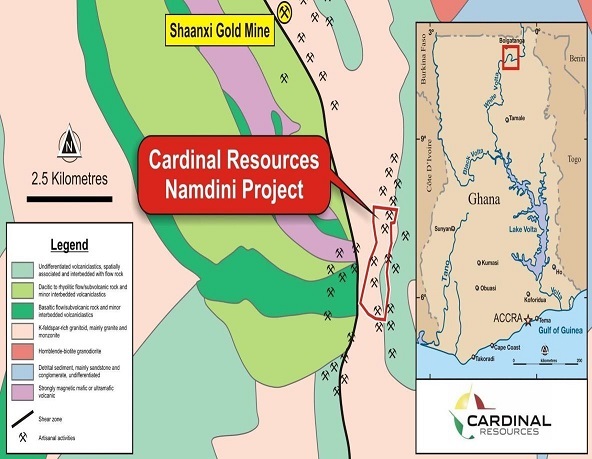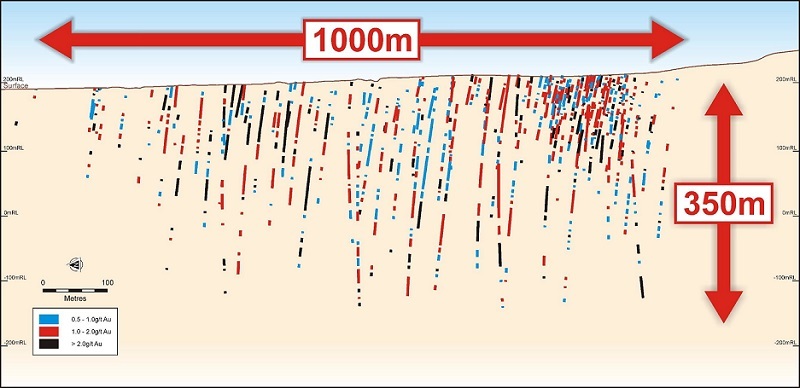Gold/Silver Investor Hub: You were asked at the recent Beaver Creek Precious Metals Summit to throw out an analogy – perhaps a West African one – to give an indication of how “big” Namdini might become. You preferred a Western Australian one: the Kalgoorlie Super Pit! Not an insignificant deposit … Do you want to expand on that, or maybe come back to something you are seeing emerge, or that has emerged, in West Africa that is comparable?
Archie Koimtsidis: There does not appear to be anything in Ghana that has such a single long (1,000m) and wide (300m) zone of mineralisation. Most mineralisation within Ghana is confined to narrower shear zones. Hummingbird Resources’ Dugbe gold project in Liberia may have some similarities (4.2Moz Au) although the mineralisation is spread over three deposits. Semafo’s Mana mine in western Burkina may also have similarities (about 4Moz Au) but the mineralisation style is unknown. Randgold's Masawa project in eastern Senegal may have similarities (about 4.5Moz Au), but the width of mineralisation is not readily available. Mineralisation there occurs within altered greywackes. Then there is Perseus’ Yaoure mine in Cote d'Ivoire (5.2Moz) which has two orebodies, one of which is low grade of about 200m width with some cross-cutting higher grade quartz veins.
Maybe this deposit could be somewhat similar to the Namdini one as far as width is concerned, but the grade might be too low to be directly comparable.
Gold/Silver Investor Hub: Specifically on the grades and widths of mineralisation you've reported in a short space of time (since last February): How do they compare with what we're used to seeing in this part of the world?
Archie Koimtsidis: The grades are roughly average for Ghana, but the widths at Namdini are very unusual for the normal Ghana gold deposits. Most others are narrower, shear-zone related, and where there may be sub-parallel shears, the intervening material is often barren or sub-economic. Namdini is not shear-zone related but has disseminated mineralisation with higher grade zones throughout the deposit – within metavolcanics, granitoids and diorites – producing a 300m-wide mineralised zone, open at depth (currently 350m) with strike extension possibilities (currently 1,000m).
Gold/Silver Investor Hub: You’re looking at posting a maiden JORC resource (inferred) number in the December quarter, along with results of extensive met tests. How much of what is expected (by the market) is currently priced into Cardinal’s latest market value/how much upside do you see?
Archie Koimtsidis: Global analysts who cover Cardinal do believe that we are undervalued and have calculated and published price targets which are much higher than our current share price.
Gold/Silver Investor Hub: Related to this, then, how much do you see that you will have to grow the resource base – using current/recent peer indicators – to get Namdini's scale reflected in a market value that is ready for advancing the project to development stage?
Archie Koimtsidis: We have previously stated that we do believe we have an excellent chance of coming up with an initial multi-million ounce JORC resource in Q4 2016. Why don’t we all wait and see how that comes up before we can fully address this great question?

Gold/Silver Investor Hub: What sort of pit depth do you see the infill drilling planned for the March quarter taking the resource outline to?
Archie Koimtsidis: We will incrementally try and grow the depth extension drilling beyond 400m of vertical. If the mineralisation keeps coming up and warrants deeper drilling, we will continue chasing it for a potential underground mining operation beyond the initial opencast pit.
Gold/Silver Investor Hub: What are some of the (prospective) development pluses you are seeing in a deposit with the characteristics this one is exhibiting (combined with the location aspects)?
Archie Koimtsidis: Mineralisation is from surface in a large portion of the deposit, hence stripping ratios will be very favourable. The minus-60-degree W-dip of the lithologies is a favourable angle for openpit mining. As mineralisation occurs throughout the 250-300m width within all three main rock types, bulk mining is a distinct possibility rather than selective mining as done in other Ghanaian deposits – assuming the met testing results show the different lithologies to be similar so that they can all be mined together.
There is sparse population in the immediate vicinity of the deposit to relocate, there is a large all-year water supply from the White Volta River within 7km, and national grid power supply is about 30km away.
Gold/Silver Investor Hub: You mentioned the restart of regional exploration after the current wet season hiatus. What form will that take/where will the focus be/why?
Archie Koimtsidis: Number one, Namdini strike extensions. We will begin a soil geochemistry program via auger drilling and if successful we will follow up with an appropriate deep hole drilling program to further explore these soil results.
Two, the Kungongo prospect, about 20km south-west of Bolgatanga town, which contains about a 6km portion of a major regional shear zone (the Bole-Bolgatanga Shear) which extends from Niger –adjacent to Samira Hill mine – through Burkina Faso (Youga mine), through northern Ghana (Cardinal tenements) and into Cote d'Ivoire. Current artisanal mining along strike on this shear has intersected significant gold mineralisation, hence this prospect will be the next focus for exploration. We await the final interpretation of a recently completed ground geophysical survey of this prospect and plan several different drilling programmes to locate mineralisation (auger for soils, then RC and diamond drilling).
Three, the Subranum project in central-west Ghana where previous exploration has outlined about 100,000oz of gold [data from Newmont] along the extension of the regional Bibiani Shear Zone [hosting the Chirano and Bibiani mines to the south-west along this shear zone]. The property contains about 9km of this Bibiani Shear Zone, confirmed by Cardinals’ airborne geophysics program completed in 2013.
Planned drilling is anticipated to enlarge the resources there.

Gold/Silver Investor Hub: Some of the big global fund managers/investors at the Precious Metals Summit talked about the premium value to be put on big deposits in safe jurisdictions over the next five years. Should Ghana/West Africa generally figure highly in this discussion/why?
Archie Koimtsidis: As for safe jurisdictions, Ghana has been Africa’s second largest gold producer for many years only behind South Africa. We do believe this couldn’t have been the case if Ghana wasn’t a safe jurisdiction.
As for geological opportunity, West Africa should always figure highly in these discussions due to vast amounts of prospective greenstones occurring throughout most of these countries: rocks of Birimian (greater extent) and Archaean (lesser extent) ages. The Birimian Gold Province of West Africa hosts most of the major gold deposits notably in Ghana, Cote d'Ivoire, Mali, Senegal and Burkina Faso, thus the probabilities of new, big deposits yet to be discovered within West Africa is high due to the vast amounts of prospective Birimian greenstone rocks occurring within West Africa.
Extensions to known orebodies have recently been announced and new deposits are likely in the near future as exploration techniques and technologies continue to improve to unearth deeper or more subtle deposits previously overlooked.
Take the Bolgatanga area for example. A number of years ago it was considered highly unlikely that large gold deposits would be found in that area. Now the big Namdini deposit has been discovered, with the possibility of other gold deposits to be discovered within that area.
Another example of recent discoveries is within a greenstone belt in Burkina Faso sub-parallel to the regional shear zone already mentioned in which Semafo has located substantial gold resources of about 1.8Moz (Natougou) and 600,000oz (Nabanga) with potential to enlarge on these resources. These deposits are far removed from the main Burkina deposits located in central, north, north-west and west of Burkina and are further examples of new discoveries being located within the Birimian Gold Province.
Burkina Faso is a prime example of a number of large gold discoveries within the past 8-10 years. Previously this country was regarded as having small, scattered gold deposits within the Birimian rocks and put on the back-burner of prospective countries in which to search for big gold deposits! Not anymore as more deposits are being located.
The Yaoure mine in central Cote d'Ivoire continues to enlarge its gold resources and recently Endeavour’s Ity mine in western Cote d'Ivoire has had a new lease of life. It was originally discovered in the 1950’s and mined intermittently on a small scale for many years with a heap leach operation. Recently substantial new extensions to the original orebodies have been discovered and vigorous exploration is being conducted over an enlarged land package along strike.
The above geological examples are just a few reasons why West Africa should figure highly in future discussions.

For more information, contact info@cardinalresources.com.au. Ph: +618 9322 6600. Web: www.cardinalresources.com.au

























